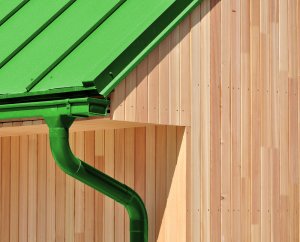Installation and Maintenance of Rain Gutters

How many times have you promised yourself you were going to install rain gutters? You probably think about it every time it rains. Well, after today, there’ll be no more excuses. Whether you already have gutters or you’re thinking about installing new ones, we’re going to tell you everything you need to install and maintain them.
The best way to protect the walls and foundations of your home from the rain is to install gutters, which help to direct the flow of water away from the side of your house.
All you need are the right materials, good planning, and a little enthusiasm. Not only will you feel a great sense of accomplishment, but your house is sure to thank you for it later. So what are you waiting for? Let’s get to work.
Installing your drainpipes

There are a few things you need to do before you start installing your drainpipes. Firstly, you need to choose where you want to install them and decide whether you want to direct the water into a rain tank, storm drain or your garden.
Your gutters should direct the water at least 3-5 ft away from the walls of your house to prevent damage to both the foundations and your lawn. You’ll also need to draw up a plan of your roof, marking where you want your gutters to go, and measuring how much guttering you’ll need. This will allow you to buy all the necessary materials.
You should be able to find guttering kits in most specialist hardware stores. These come with all the instructions you’ll need to install the various brackets and supports.
Remember to place your gutters on a slight incline rather than completely straight. This will allow the water to flow freely toward the downspout.
Maintaining your rain gutters

Proper gutter maintenance is essential. It has two main purposes: to ensure the water can flow freely during heavy storms and is directed away from the house and to prevent the build-up of harmful mold. As you’ll soon discover, maintaining your rain gutters is much easier than you think.
First, make sure you have all the necessary materials. You’ll need a pair of sturdy work gloves, a ladder, a small spade, a hose, and a rake to clean the leaves from your roof. You may also want to buy a repair kit in case of any holes or cracks.
- Firstly, you’ll need to clean your roof, using a rake to remove any leaves or other debris. This will help ensure that your gutters are clear and won’t get blocked during the next heavy storm.
- Next, check for any leaks, rust or holes.
- Once you’ve made sure everything is in good condition, you can clean out your gutters. This can be done with a spade or by hand, making sure to wear gloves to prevent any accidents.
- Once you’ve removed any solid residue, you can use the hose to clean the gutters thoroughly.
Safety first

Your hips should never rise above the top step of your ladder, so make sure it is tall enough to carry out all the necessary work comfortably. Never try to install or maintain your rain gutters from the roof itself.
Before you get started, check for any ice or frost to make sure you don’t slip. Avoid lifting large tools or long pieces of guttering while on the ladder, as it’s all too easy to overbalance.
Always start by cleaning the section of guttering closest to the downspout outlet. That way, you can prevent dirt from building up in the downspout and causing blockages. You should also remember to check the downspout filter and clean it if necessary.
If you don’t feel comfortable installing your gutters, or your roof is too high for you to safely maintain them yourself, you should always seek help from a professional.
Similarly, if you notice that your downspout is blocked, it’s best to hire a cleaning company to repair it for you. Maintenance should be carried out twice a year, at the start of spring and in the fall.
How many times have you promised yourself you were going to install rain gutters? You probably think about it every time it rains. Well, after today, there’ll be no more excuses. Whether you already have gutters or you’re thinking about installing new ones, we’re going to tell you everything you need to install and maintain them.
The best way to protect the walls and foundations of your home from the rain is to install gutters, which help to direct the flow of water away from the side of your house.
All you need are the right materials, good planning, and a little enthusiasm. Not only will you feel a great sense of accomplishment, but your house is sure to thank you for it later. So what are you waiting for? Let’s get to work.
Installing your drainpipes

There are a few things you need to do before you start installing your drainpipes. Firstly, you need to choose where you want to install them and decide whether you want to direct the water into a rain tank, storm drain or your garden.
Your gutters should direct the water at least 3-5 ft away from the walls of your house to prevent damage to both the foundations and your lawn. You’ll also need to draw up a plan of your roof, marking where you want your gutters to go, and measuring how much guttering you’ll need. This will allow you to buy all the necessary materials.
You should be able to find guttering kits in most specialist hardware stores. These come with all the instructions you’ll need to install the various brackets and supports.
Remember to place your gutters on a slight incline rather than completely straight. This will allow the water to flow freely toward the downspout.
Maintaining your rain gutters

Proper gutter maintenance is essential. It has two main purposes: to ensure the water can flow freely during heavy storms and is directed away from the house and to prevent the build-up of harmful mold. As you’ll soon discover, maintaining your rain gutters is much easier than you think.
First, make sure you have all the necessary materials. You’ll need a pair of sturdy work gloves, a ladder, a small spade, a hose, and a rake to clean the leaves from your roof. You may also want to buy a repair kit in case of any holes or cracks.
- Firstly, you’ll need to clean your roof, using a rake to remove any leaves or other debris. This will help ensure that your gutters are clear and won’t get blocked during the next heavy storm.
- Next, check for any leaks, rust or holes.
- Once you’ve made sure everything is in good condition, you can clean out your gutters. This can be done with a spade or by hand, making sure to wear gloves to prevent any accidents.
- Once you’ve removed any solid residue, you can use the hose to clean the gutters thoroughly.
Safety first

Your hips should never rise above the top step of your ladder, so make sure it is tall enough to carry out all the necessary work comfortably. Never try to install or maintain your rain gutters from the roof itself.
Before you get started, check for any ice or frost to make sure you don’t slip. Avoid lifting large tools or long pieces of guttering while on the ladder, as it’s all too easy to overbalance.
Always start by cleaning the section of guttering closest to the downspout outlet. That way, you can prevent dirt from building up in the downspout and causing blockages. You should also remember to check the downspout filter and clean it if necessary.
If you don’t feel comfortable installing your gutters, or your roof is too high for you to safely maintain them yourself, you should always seek help from a professional.
Similarly, if you notice that your downspout is blocked, it’s best to hire a cleaning company to repair it for you. Maintenance should be carried out twice a year, at the start of spring and in the fall.







